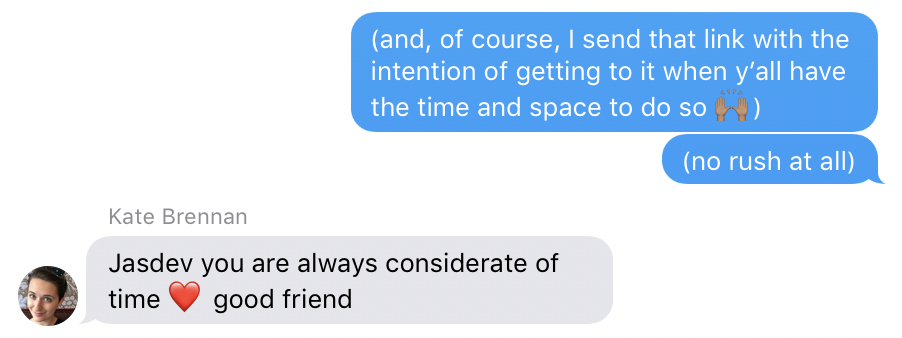No response needed
07 Oct 2017When I got my first iPhone back in 2012, I was a devoutly against read receipts. I wanted the space to reply without the (false) worry that my friend on the other end is silently wondering “omg, Jasdev hasn’t replied in four minutes since seeing my message‽” Over the years (and after reading Rosemary’s fantastic post on the topic), I’ve changed my mind. I now leave read receipts on by default1. This change of heart got me thinking about how to better respect personal/friends’ energy levels in digital contexts.
Digital Contexts Cover Social Cues
Messaging—both individually, and in groups—has allowed me to have always-on conversations with those close to me. However, unlike in-person conversations, it’s tough to pick up on social cues (e.g. being visibly tired or distracted). How do I relay to a friend that battling UINavigationBar’s API all day might not leave me in a state to have a conversation on deep life topics™? How do I hint to a coworker that I’m exhausted and want to defer a discussion until tomorrow? Read receipts establish these boundaries. I’d rather signal that I’m ready to reply when I have the time and emotional energy to do so (critical and time-sensitive messages aside). And I want my friends to do the same! Nothing makes me happier than seeing those around me prioritizing self care. Messaging when ready is an instance of this.
A way I’ve seen this nuance addressed is by deliberately acknowledging it, which brings me to the title of this post: “No Response Needed.”
Acknowledging One Another’s Time and Space
Two of my dearest friends, Kate and Jason, and I have an ongoing thread packed with dank tweets, work from our favorite illustrators, and posts that make us pause. When sending a longer read to the group, we nix the ounce of stress associated with yetanotheritem on our reading lists by being open about personal time and space.

NRN
I’ll often want to send a message to someone I’m thinking about without the imposed pressure to segue into an open-ended “Hey, how are things?”-conversation. Ryan recently used an acronym that captures this nicely, “NRN.”

Ending thoughtful texts—“Hi, I miss your face Toshi. Please move back to NYC.”—with “NRN” signals a digital pulse instead of an obligation to reply immediately.
Thinking generally, AIM (RIP) Away Messages might’ve been onto something when it comes to online social cues. Just because you’re online, doesn’t mean you have to respond.
Posting is Different than Conversing
I no longer buy into the idea that one shouldn’t post online if they have haven’t replied to emails, texts, etc. Posting is different than conversing.
if i haven't responded to your text and you've seen me post 50000 times since, i'm sorry but posting and talking are different energies
— Brain Mentality (@ByYourLogic) March 17, 2017
Tangentially, Derek Sivers pointed out how “digital talking” can ironically leave us fatigued to do the same in-person:
I’ll sit alone in my little office for 8-10 hours, engaging with 100 people’s lives and questions for a few minutes each, and then go home.
Then when friends want to hang out with me, I say I need some alone time first.
They say I’ve been alone all day. So I explain that I’ve been massively social all day long, and feel spent, even though I’ve been sitting alone.
I like it, so I’m not complaining — just explaining. It’s unusual to be physically alone, but extremely social. A solitary socialite.
Funny how the above thoughts stemmed from a single setting on my phone. I’m beyond grateful to be physically and digitally surrounded by friends and family. However, the lack of social cues in the latter context means that we should reply when we’re ready. Doing so helps both sides of the conversation.
Special thanks to Kate, Jason, and Will for reading early drafts of this entry.
Related Links and Footnotes:
⇒ The best: someone addressing all of a multipart text
-
This doesn’t have to be binary! iOS let’s you selectively enable receipts for specific contacts. ↩